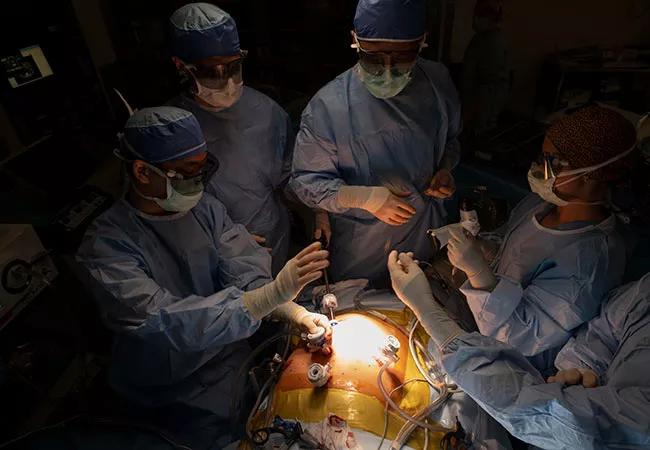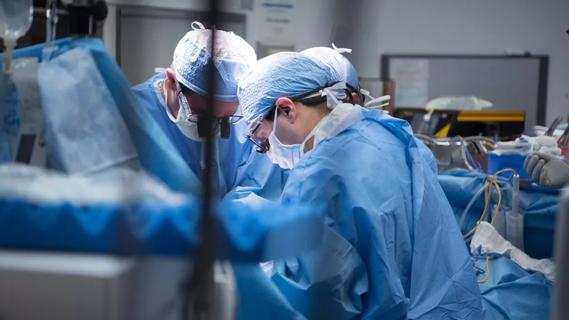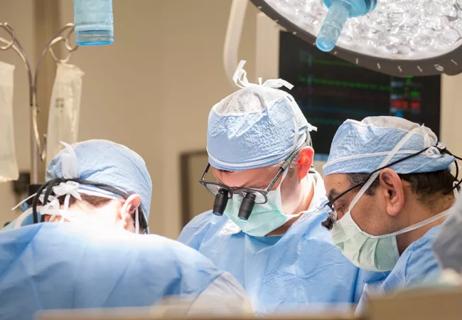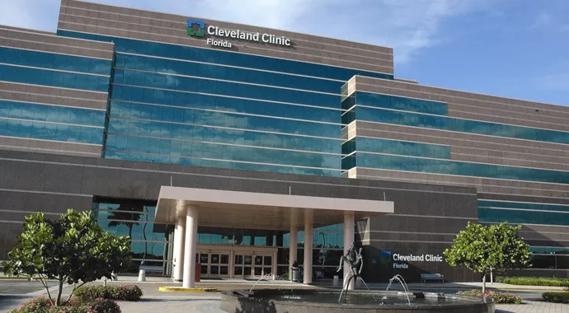Advertisement
Cleveland Clinic’s team reviews progress and offers guidance

In the nearly two decades since the first fully laparoscopic living donor hepatectomy for liver transplant was performed, the procedure’s safety, feasibility and prospective benefits for donors in terms of rapid recovery, pain reduction and cosmesis compared with open resection have been established.
Advertisement
Cleveland Clinic is a non-profit academic medical center. Advertising on our site helps support our mission. We do not endorse non-Cleveland Clinic products or services. Policy
However, the availability of laparoscopic living donor hepatectomy (LDH) involving either partial- or full-lobe resection remains limited to an extremely small number of tertiary care centers, primarily in Asia. The lack of expansion to Europe and North America likely is due to the complex surgery’s steep learning curve, skepticism about its applicability in Western countries where patients have relatively larger body mass indices, and lingering concerns about donor safety.
Only one U.S. center previously has reported a case series of fully laparoscopic LDHs for transplant. The 51 procedures — 31 left-lateral sectionectomies and 20 full lobectomies — were performed between 2009 and 2017 at New York-Presbyterian Weill Cornell Medical Center.
Cleveland Clinic’s laparoscopic LDH program, led by Director of Laparoscopic Liver Surgery Choon Hyuck David Kwon, MD, PhD, began in August 2019 and has rapidly progressed to become the nation’s most active provider. Dr. Kwon and colleagues have performed 42 fully laparoscopic LDHs in the program’s first 18 months. In a new report, they summarize the outcomes of the initial 19 full-lobe donors and offer guidance for other institutions considering initiating programs.
Launching fully laparoscopic living donor liver transplantation is a complicated endeavor that can have substantial patient benefits but requires key preparatory steps, Dr. Kwon says — most notably the involvement of a skilled and highly experienced senior surgeon, acquisition of essential equipment and conducting appropriate team training.
“There are a lot of ingredients that must be in place for a program to launch,” he says. “Our initial results are very encouraging. In the first 1 ½ years, the program has developed in such a way that it gives us confidence we can push boundaries.” Those include steadily increasing the number of laparoscopic hepatectomies, taking on more challenging cases and training additional surgeons.
Laparoscopic LDH has advanced from the inaugural 2002 cases — left-lateral sectionectomy in two adult-to-child transplants — to the first full right-lobe donor hepatectomies in adult-to-adult transplants in 2010 (reported in 2015). Right-lobe hepatectomy is now the predominant form of adult-to-adult laparoscopic LDH, owing to the frequent need for large-volume grafts to accommodate adult body sizes.
A substantial amount of experience in both oncologic liver resection and open living-donor hepatectomy is necessary in order to undertake laparoscopic LDH. While the minimally invasive approach has the potential to reduce open-procedure morbidity (infection, adhesion and hernia), laparoscopic surgery diminishes instrument maneuverability, which creates challenges for spatial orientation during blood vessel and bile duct dissection and for rapid response in the event of hemorrhage or other complications.
Advertisement
Dr. Kwon founded the laparoscopic LDH program at South Korea’s Samsung Medical Center in 2013. He and his team had performed more than 350 major and minor laparoscopic hepatectomies and more than 1,000 open living-donor transplants before achieving the level of technical proficiency and confidence he felt was necessary to attempt fully laparoscopic LDH. He went on to become one of the world’s most experienced laparoscopic LDH surgeons.
That expertise led Cleveland Clinic to recruit him in late 2018 to start the nation’s second — and the Midwest’s first — laparoscopic LDH program. He and his team spent nine months preparing for the first surgery.
“You have to work out the learning curve for laparoscopic living donor transplantation with cancer resections first,” Dr. Kwon says. “It’s a very complicated surgery and you’re not going to be able to make the transition to fully laparoscopic living-donor cases unless you have been routinely doing laparoscopic liver resections, including major hepatectomies.”
Having the oversight and guidance of a surgeon with laparoscopic LDH experience is another key determinant of a new program’s success. That can be accomplished either through a short-term visiting proctor or, as in Dr. Kwon’s case, hiring a resident expert.
To prepare for the start of Cleveland Clinic’s laparoscopic LDLT program, Dr. Kwon and his assisting surgeons — each of whom has more than 10 years of experience in open oncological liver surgery and living donor hepatectomies — operated together in liver resection cases, ultimately executing half of those cases laparoscopically. A dedicated team of scrub nurses and technicians was assembled, trained and took part in those procedures.
Advanced surgical equipment to help ensure optimal outcomes was purchased. The items Dr. Kwon recommends include:
Advertisement
Dr. Kwon notes that instrument sterilization protocols need to be adjusted to take into account the delicacy of the advanced laparoscopic equipment used in LDH.
Conservative donor-selection criteria were instituted at the Cleveland Clinic laparoscopic LDLT program’s startup to safeguard patients and allow for a stepwise increase in case complexity as the team gained experience. Donor candidates with a history of abdominal surgery or complex hilar anatomy initially were excluded, although those restrictions were lifted after a review of the first 10 cases showed the challenges were manageable.
Conversion from a laparoscopic to an open approach — both during the training-phase liver resections and in the LDHs once the program was underway — was always an option if the team encountered difficulties or the operative time became extended. “It’s no sin to begin a case and do as much as you can laparoscopically, then convert to open as necessary, Dr. Kwon says.
Because laparoscopic LDH is still considered a developmental procedure, and because adverse events are always a possibility in complex surgeries, Dr. Kwon says it is essential to establish a supporting team and protocols for crisis management before the program begins. As Cleveland Clinic Enterprise Director of Transplantation Charles Miller, MD, and colleagues observed in a 2013 journal article, the inherent risk means a donor death may be an inevitable event for LDLT programs, but effective planning and response “can minimize damages and losses and allow an organization to emerge stronger than before the crisis.”
Advertisement
Of the 19 laparoscopic LDHs performed at Cleveland Clinic during the program’s first year, none required open conversion or blood transfusion. Median operative duration was 372 minutes. Median postoperative hospital stay was five days. No patients required readmission. The majority (13 patients = 72%) resumed normal physical activities within six weeks of surgery; the remainder reported full functioning by three months.
With open LDH, the rate of major complications typically ranges from 2% to 10%, and minor complications 20% to 40%, Dr. Kwon says. No major complications occurred among Cleveland Clinic’s first 19 patients. Only one donor (5.3%) developed a minor postoperative wound infection (Clavien-Dindo grade II).
Thirteen patients donated their full left lobe (with or without caudate); five donated right lobes; and one donated the left lateral liver segment. Although acquisition of the smaller left lobe is considered safer for the donor, right-lobe resections are predominant in other laparoscopic LDH programs in order to provide adequate graft volume and function for larger adult recipients.
Dr. Kwon says Cleveland Clinic has been able to develop a left lobe-dominant program by modifying both the donor and recipient surgeries. Obtaining the caudate lobe along with the left lobe of the donor liver boosts the functional graft size. Modulating portal venous pressure by splenic artery ligation prevents excessive portal flow to the graft, alleviating the risk of overflow injuries that are believed to cause small-for-size graft syndrome and enabling the use of grafts as small as 35% of standard liver volume while maintaining good survival.
A left lobe-dominant laparoscopic LDH program that safeguards donors and provides optimal recipient outcomes “is going to be a game-changer,” Dr. Kwon says.
Next steps for Cleveland Clinic’s laparoscopic LDH program involve steadily increasing the number of transplant performed and providing training and additional services.
Dr. Kwon intends to grow the program by 20 cases per year, reaching 100 cases annually by 2024. That would make the program by far the nation’s largest. The expansion would include performing more laparoscopic LDHs for pediatric recipients and broadening the eligibility criteria for the laparoscopic approach so that more donors may benefit. “Since November 2019, all of our living donor hepatectomies have been performed laparoscopically and we would like to continue that progress,” Dr. Kwon says.
There are plans to start a mentoring program that will pair previous liver graft donors with prospective ones, to answer their questions and help them understand what to expect. A weight-loss program also will assist donor candidates with excessive body mass by connecting them with metabolic specialists who can explain weight-loss strategies and healthy lifestyle changes.
Later this year, Dr. Kwon also aims to launch a weeklong educational course allowing visiting surgeons to learn about Cleveland Clinic’s laparoscopic LDH program. Longer observational and participatory sessions will be available for those who seek a more immersive experience that can serve as a foundation for visiting surgeons to begin their own programs.
Advertisement
Advertisement

ctDNA should be incorporated into care to help stratify risk pre-operatively and for post-operative surveillance

Program's approach maximizes donor safety without compromising recipients' outcomes

An analysis of resource utilization

Effective HCV treatments enable transplantation of HCV-positive organs to HCV-negative patients

Exponential growth, complex cases, shorter wait times

Insights from Cleveland Clinic’s Vice Chair of Innovation and Technology

Cleveland Clinic study finds that durable weight loss is key to health benefits

Findings could help promote organ preservation